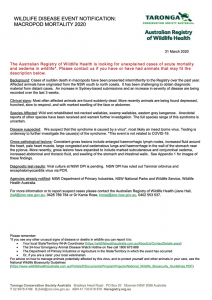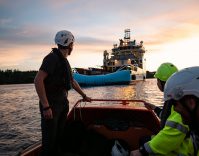Kangaroo Killer Virus Remains Unmanaged
March 2020 – An unknown virus is claiming a significant number of Macropods and the call out is on requesting Veterinarians and Wildlife Carers to be vigilant.
in 2017 a broadcast to Veterinarians and Carers went seemingly unnoticed in the Public Domain.
There was no public announcement made and given that there is a Kangaroo “Paddock to Plate sector” it is more than a little disturbing that there were no pubic notices issued, no testing of Kangaroo meat for either Human or Pet consumption.
The regulatory body in charge of testing National Residue Office – provides no input to the death of Millions of Kangaroos notified in 2017 attributed to this unidentified virus, its notification went without fanfare, ongoing investigation or addition of testing for meat available for consumption.
THERE ARE CURRENTLY NO REQUIREMENTS TO TEST FOR ANY DISEASE IN KANGAROO FOR EITHER PET OR HUMAN CONSUMPTION
Skip ahead to March 31 – 2020 and a renewed call out for carcasses to allow further research into the mortality causation.
Noting there remains – no testing or recording of this mortality causation in the food industry.
Given the current world Pandemic brought about by Zoonotic crossover diseases – with virtually a world shutdown due to a Cornavirus strain “Covid 19” Pandemic.
It would seem more than reasonable for the general public to ask why the food available for Human consumption is not required to test for such things as Zoonotic diseases?
Questions raised in 2017 by, DPI Veterinary officers, CSIRO, Carers and people who became aware remain unanswered.
SUSTAINABLE HARVEST The Commercial Kangaroo Industry claims it is one of the most sustainable wild harvest operations in the world.
Commercial harvest is permitted for:
- Red kangaroo • (Macropus rufus), harvested in NSW, Qld, SA, WA
- Eastern grey kangaroo • (M. giganteus), harvested in NSW, Qld
- Western grey kangaroo • (M. fuliginosus), harvested in NSW, SA,WA
- Common wallaroo or euro • (M. robustus), harvested in NSW, Qld, SA, WA
- Bennett’s wallaby• (M. rufogriseus rufogriseus), harvested in Tas.
- Tasmanian pademelon (a species of wallaby) • (Thylogale billardierii),harvested in Tas
REGULATED The industry claims to be highly regulated, operating under a quota system monitored by both State and Federal Governments. The oversight manages sustainable harvesting limits independent of demand.”
- All ‘harvesters’ must be accredited and licensed by State agencies
- Harvesters and Processors must operate under strict hygiene and animal welfare Codes of Practice.
- Harvest quotas are set at the maximum number of slaughters permitted annually based directly on population surveys.
- Tagging and licensing systems ensure that quotas are not exceeded
NSW regulations 2017-2021
QLD regulations 2018-2022
SA regulations 2020-2024
WA regulations 2019-2023
Having a murky past, the Commercial Kangaroo industry is SELF REGULATED and has been called to account in relation to Meat Substitution, cruelty, coverups, contamination and questionable practices.
Regardless of implied procedures:
- Kangaroos by their biological makeup cannot be farmed,
- Kangaroos are not housed so are killed at night in paddocks or bush settings,
- There is little to no water or hygiene facilities in immediate locations.
- Kangaroos
Income from Kangaroo slaughter includes meat for human and pet consumption and skins for leather products. Minimal produce is used domestically, the rest is exported to more than 55 countries. The largest portion of meat for human consumption is exported.
Historical claims dating back to 2001 are that the Harvest Quota represents less than 3% of the total kangaroo population.
THE INDUSTRY IS FUNDED via a “macropod slaughter levy” payable by the processor for each animal, with the Australian Government contributing half of program expenditure as the program funds are expended.
This slaughter levy is administered by the Department of Agriculture
 The Macropod Slaughter levy is collected per animal and is payable by processors.
The Macropod Slaughter levy is collected per animal and is payable by processors.
The Australian Government contributes half of program expenditure as program funds are expended. Australian Government contribution is capped at 0.5% of the Gross Value of Production.
The Slaughter Levy is collected and distributed via the Department of Agriculture.
Research includes focus on Trade barriers and Food Safety noting specifically the desire to – generate scientific data to satisfy regulators that gamma irradiation is a safe treatment for kangaroo meat,
NUMBERS DON’T ADD UP with a history of issues, industry players have come under minimal scrutiny.
On the one hand, the industry bodies claim that Kangaroos are in plague proportions,



